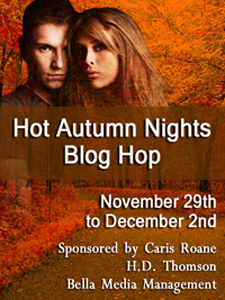R. Lee Smith's Blog, page 24
January 4, 2014
Weekend Writer Warrior 1/4/14
The Weekend Writing Warriors blog hop is a weekly event in which writers are invited to share eight sentences from one of their works for other writers, readers and random bloggers to read, critique and comment on. Visit their site by clicking on the button below for a list of other participating writers and share the love! Today’s 8 comes from Pool, my current work-in-progress, in which I get back to my monster movie roots. Today’s snippet provides a little more local history about the mine Norah has inherited (and will be living in while she and her friends clean it up…all alone…miles from anywhere…). Enjoy!
“When I was a boy, they found a leg maybe five miles east of here. It was all black and shrunken in, but still wearing a beaded slipper and a pink garter. It had a tattoo on the ankle of a gold dollar, so they were able to identify it as belonging to Molly Dollar, one of the whores that worked the bar where you fine folks’ll be bedding down tonight.”
John uttered a terse, humorless laugh and said, “Ghost stories, really?”
“Take what you want from it, boy. No ghost left the toothmarks on that leg, though. No bear, either, in spite of what the state wanted us to say. Coroner was pretty sure those were left by a man.”


December 28, 2013
New Year’s Resolution #1 Blog More
Did I really let a whole month go by without blogging? I’m so sorry. I’ll try not to let that happen again, although I must say that after the daily posts of November, I needed a break to just sit and actually work on a book for a change. I think I’m going to stop doing Wednesday’s Hump Day Hook, since the list of participants has shrunk from an average of 30 to only five or six. That leaves me with either counting paragraphs for Sneak Peek Sunday or sentences for Weekend Writer Warriors. It would be nice to find another regular (and active) blog hop out there that posts mid-week so that I get a post in every few days instead of two back-t0-back and silence for the rest of the week. I dunno. I’ll keep looking. In the meantime, look for regular blogging to resume after January 1st. That’s New Year’s Resolution #1.
I hope all my readers out there had a Happy Whatever and now that the holidays are over and the aftershocks are dying down, it’s time to reflect on our aspirations for the new year. Resolutions have always been (for me, anyway) a short-lived dream. I’ve usually broken most of mine by the end of the first month, but I have decided this is the year I finally get my shit together. The latter half of 2013 was almost a total wash, due to one thing or another (the most notable ‘thing’ being my surgery, from which I am mostly recovered, although I still have difficulty sitting for long periods at a time…like at the computer…typing…) and I’ve let that be the reason I’m not further along on Pool than I should be. But I still have hopes of publishing it within the next year, so we’ll call that Resolution #2.
Blah blah blah lose weight blah blah work out blah carbs blah stop eating so much delicious crap blah blah blah no one wants to read another weight loss resolution. And that’s #3.
Resolution #4: Learn another language. I’ve wanted to do this for years, but never got around to it, apart from a year of French in high school (and I’ve forgotten nearly everything but the swears). This year, my sister got me a year’s worth of Rosetta Stone, so all that remains is for me to pick the language. I’m going with Greek. It’ll come in handy when I write my next book and it’s obscure enough here in the Midwest that I can probably swear in public without offending anyone. That’s an important consideration for me.
Finally, stop swearing so much. It would seem this resolution is in direct contradiction to the previous one, but at least if I’m swearing in other languages, my sister’s macaw isn’t increasing her vocabulary of profanity in this one. She’s become quite the salty little sailor since I moved in with Cris and her husband. I’m not sure yet whether this resolution will bleed over into my books or not, but I have to admit, The Last Hour of Gann was a bit thick with colorful metaphors.
So there we have it. Blog more, publish Pool, lose weight, learn Greek and quit cussing. It’s going to be a full, fun year for me. What’s on your list?


December 3, 2013
Author’s Spotlight: Layna Pimentel
Congratulations to Deljah, who won my Hot Autumn Nights Giveaway and received a free copy of Cottonwood! I hope you all enjoyed reading so many talented authors and will come back for the next HD Thomson blog hop: Winter Wonder Man! More details as soon as I get home and find out what they are myself.
Today, I am pleased not only to congratulate Deljah, but to shine the author’s spotlight on Layna Pimentel, who in addition to helping me out on Candy Crush from time to time is a damn fine writer. She has a new title coming out soon and has graciously allowed me to promote it here on my blog. For all of you who enjoy a little leather with your lace, Layna Pimentel is a must-have for your personal bookshelf and her new book, Stay With Me, is a particularly delicious little shiver of a read that explores all the darkest colors of BDSM seduction. Sexy without being sleazy, Layna’s writing paints that razor-fine line between danger and desire and I cannot recommend her enough!
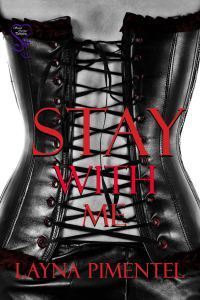
Coming soon to Secret Cravings Publishing…
Master Alex is furious when a friend’s submissive invites a naive stranger to his party. With his reputation on the line, he must keep her out of trouble and away from curious Doms. Observing signs of interest from her, he leads her down the path of wicked temptations. However, when his ex-sub pushes her way back into his life, he tries to find a balance between his discreet life and his public one.
Mercedes is fearful of the world she’s stepped into, but the curiosity of what pleasures lie beyond keep her interested in far more than the play. All is going well until a jealous woman convinces her she’s out of her league. Desperate to regain control over her life and heart, she pushes Alex away.
Will these two manage to find their way to each other, or is their relationship doomed from the moment they meet?
* * *
Born and raised in Toronto, Ontario, Layna discovered her love of reading at an early age. When she isn’t devouring salacious romance novels or writing, she enjoys losing herself in researching ancient history and mythology, weaponry, and hiking. She lives in Northern Ontario, with her husband and two daughters.
Layna is a member of the Romance Writers of America, creator of the Romance Author at Large blog, and is a monthly contributor at 69 Shades of Smut. For updates on her upcoming releases, or to leave her a comment, you can find her at:
Blog: laynap.wordpress.com
Website: www.laynapimentel.com
Twitter: www.twitter.com/LaynaPimentel
Facebook: www.facebook.com/AuthorLaynaPimentel
Want to be the first to catch some sneak peeks into her upcoming releases? Of course you do! So subscribe to her newsletter here: http://eepurl.com/FOPP1


November 28, 2013
Hot Autumn Nights Blog Hop
When asked to say a few words about hot autumn nights, I confess I was initially stumped. You see, I am originally from the Great Pacific Northwest, where autumn means sitting on the back porch on a cold, clear night with a mug of cocoa, watching deer graze in the back field with the scent of burning leaves on the wind. But I don’t live there anymore. I live in the Midwest now, where autumn means the second season of storms is upon us, bringing with it alternating nights of sweltering or freezing (as well as the pleasant threat of tornadoes), and the only scents on the ever-present wind emanate either from the oil refinery to the east or the stockyard to the west. Nothing about this Godforsaken place is romantic. The only reason people around here have babies is because of boredom.
On the other hand, I did sign up for this blog and I feel a faint sense of obligation to commit to it because HD Thomson is awesome. So let’s forget about autumn and focus on the night.
As my mother was wont to say when I balked at venturing down into our child-eating haunted basement for a bottle of peaches, there’s nothing in the dark that isn’t there in the light. Why then, is darkness so inherently sensual?
Sight is arguably the most complex and most relied upon of the traditionally recognized senses. When we lose it, we lose a lot of what anchors us in familiarity. As a teenager, after reading The Cay by Theodore Taylor, I put on a blindfold for a solid week to see what it would be like to suddenly lose my vision (I had very understanding parents). What I discovered almost immediately was that darkness makes everything strange. Anyone who’s ever stubbed their toe walking across their own bedroom at night knows this and likewise knows that walking across the bedroom in the dark means going slower, orienting yourself by the ticking of the clock or sleeping breaths of whoever’s sharing your bed, trailing one hand lightly along the wall and feeling out every step before you take it. Daredevil’s example to the contrary, our remaining senses are not superhumanly heightened by a lack of sight, but we do become more attuned to the cues that are already there and because we are not accustomed to processing that information, the experience becomes one of exploration and anything that makes sex seem new is always thrilling.
As a writer, it can be a challenge to take the very basic mechanics of sex and use them in a scene that is unique to certain characters in a specific circumstance. No sex scene should be interchangeable with that of another book or even one appearing at a different time in the same book. See, here’s the thing: Sex scenes aren’t really about sex. They are about the connection between characters, which is not necessarily a romantic one. People have sex for a lot of different reasons, but whatever desire, passion or desperation moved your characters into that position (so to speak) should be reflected in the action as much the emotions. Therefore, writing a sex scene can’t come too close to writing a sex manual. A step-by-step narrative is not hot. The trickle of sweat following the curve of the heroine’s spine or the scrape of the hero’s teeth across the nape of her neck is. So using all five senses during a description of sex is one of the most important tips I could give a new writer, one that should be applied whether the scene takes place during the night or day.
But night is when the writer’s skill at using every sense really pays off. At night, there are little visual cues beyond the pale reflection of moonlight glinting in his eye or the curve of her hip falling into shadows. Here, the whole story is told by Braille. The scars he has seen by sunlight, he now feels as if for the first time as he caresses her. Inhuman characteristics that are obvious to the eyes take on whole new dimensions: the tickle of fur on her naked belly, the coolness of his horns, the unexpected muscular grip of his tail wrapping her ankle, her hand tracing the sensitive skin along the unfeeling metal prongs ridging his armored spine. In the dark, just as touch seems so much more exaggerated, sounds seem amplified. The shuddering of her breath, barely perceptible by daylight’s distraction, trembles in the very air at night. The rasp of his hand sliding over her skin is almost a physical thing to her ears. The taste of his sweat, the scent of her hair, the musk they make as they come together—in the dark, it is possible to describe sex without ever using a dirty word and still leave the reader thinking they have just read the most graphic scene imaginable simply because so much of it is left to the imagination and nothing is so graphic as what a reader can imagine.
Beyond the five senses, there are feelings to explore. When writing from a character’s point of view, keep that character’s thoughts in the scene. More than just the blood races during sex; thoughts fly and emotions spill over. Don’t be afraid to use dialogue. When was the last time you had sex in total silence? And remember that the darkness has a special power when words come out. Remember when you were a kid on a sleepover, whispering to each other in the dark through all hours of the night? Even as children, we instinctively understood that secrets are more binding in the dark, truths are more intimate and lies are more devastating. Use that to your advantage. Avoid overly sentimental pillow talk and overly crude dirty talk, just be real. You don’t need flowery I-love-you-more-thans and Oh-do-me-harders to make an impact. The power will come from the characters, even if all they say is, “Yes.”
Finally, I would be unpardonably remiss as a writer of paranormal romance if I didn’t mention that, with all respect to my mother, there is something in the dark which is not there in the light: The unseen. Darkness conceals and so it follows that the things that go, ahem, bump in the night may not be entirely trustworthy. An element of danger can add immeasurably to your sex scene, whether it comes from a lover who brings the darkness with him/her or some outside threat gathering its strength somewhere unseen in the night, there’s nothing like a little shiver to emphasize the heat.
In memory of those bygone days in the Great Pacific Northwest, I am holding a Hot Autumn Nights giveaway! On December 3rd, ONE lucky winner will win the grand prize (when there’s only one prize, it can be as grand as you please): winner’s choice of one of my ebooks, or a hot cocoa gift set. All you have to do to enter is leave a comment in the section below containing a viable email address so I can contact you, and whether you want the book or the cocoa. A word or two about my post would be nice too.
If you’d like to more insight on the power of the night, please be sure to check out the rest of the blog hop for more musings from excellent authors, most of whom remembered to actually include the ‘autumn’ in ‘hot autumn nights.’ Thank you, HD Thomson, for another fun hop!


November 25, 2013
Z is for Zoology
Z is for Zoology
The total lack of cities, roads or any other distraction made the small groups of animals grazing on the plains impossible to miss. To Amber, whose personal experience with animals could be almost entirely summed up by dogs, cats, rats and roaches, they didn’t look too scary. Long-necked bodies and four thin legs made them look more or less like deer, except that they also had long tails. Instead of antlers, they had a set of back-sweeping horns, in addition to which they also had two huge jutting tusks. Their shiny, scale-covered skin was brownish on top and black underneath, with a white stripe on their bellies that only showed if they stood up on their hind legs, which two of them kept doing, gronking and clawing at each other with their hoofless, taloned feet. –The Last Hour of Gann
* * *
Two ponies—those cute little cloven-hoofed horses—banged into their chosen hopper, knocking it out of the air mid-leap. The other ponies were on it in an instant, abandoning the rest of the hoppers and letting them vanish into the tall grass. Cute little pony-mouths opened. They went right for the hopper’s neck, and unlike lions, who suffocate their prey with a similar bite, these adorable little ponies ripped the throat right out of it. –The Care and Feeding of Griffins
* * *
Wow, last letter. November has just flown by, hasn’t it? And I’ve saved one of the best for last. I touched on animals briefly as they contribute to a viable ecosystem, but it’s certainly a subject worthy of its own day in my Nanowrimo worldbuilding series. Designing the animals that inhabit my alien worlds is the funnest part of the job for me, but it’s important to remember that it is a job and the most essential aspect of that job is to tell my story plausibly. That means I can’t get so carried away creating fantastical animals that I forget they have to be able to have evolved on that world and occupy a niche in that environment. And that means more science.

“Oh for God’s sake, not again!”
Yes. Again.
As always, the best place to start researching fictional animals is to look at the real ones. My go-to resources for real-world inspiration are my Smithsonian Institution’s Animal, the American Museum of Natural History’s Ocean, the Amber Books edition of Dinosaurs edited by Carl Mehling. I also own the complete set of Walking with Dinosaurs, including Prehistoric Beasts and Cavemen, and the BBC documentaries Blue Planet, Planet Earth and Frozen Planet. The better you understand what makes animals successful in different conditions, the more realistically you’ll be able to portray animals in your fictional world.
Here on Earth, we classify animals based on shared physical characteristics. Please note that sharing characteristics doesn’t mean sharing an appearance. One of the more irritating things about James Cameron’s Avatar (among the many, many irritating things to choose from) was that all the creatures, plants and blue bunny-people looked uncomfortably similar, like they were six generations at most descended from the giant glow-stick that gave them all life. Animals are wildly diverse, even within the same group or, heck, the same ecosystem. Lions, baboons, elephants, meercats and giraffes are all mammals who share territory and look nothing alike. Diversity is your friend, especially in a fantasy setting.
Another thing to remember is that the ways we classify animals on Earth mean exactly nothing when it comes to classifying animals on an alien world. Meoraq, the hero of The Last Hour of Gann, is a dumaq, a race with a distinctly lizard-like appearance, but he is not a reptile—he’s not cold-blooded and his people do not lay eggs. You’re not ‘breaking the rules’ if your giant insect-like monsters have an exoskeleton as well as bones, you’re just not on Earth. In your own world, you can do anything.

An attitude that has led to many a Syfy Original Picture.
But no matter what planet you’re on, every feature of your alien animal has to serve one of three purposes: it has to help it get food, help it avoid being killed, or help it attract a mate. This is non-negotiable and yes, I will come to your house and tell you in detail why your multi-armed, spike-shouldered tentacle butterfly would never exist. I have a lot of spare time and I enjoy road trips and making people cry, so use common sense in your creature design. It’s not that hard, really. You can get away with a lot in the name of attracting a mate—wild colors, crests, big horns, a professed love for romantic comedies.
As for other characteristics, they depend largely on what your animal eats and what’s eating it. The main thing to remember is that your resources are limited, even if you don’t have a human-like top-tier race encroaching on their habitat. Herbivores often develop very specialized diets to compensate for this; one animal might graze on grass while another browses on branches and yet another noshes on nuts. Plants do a very good job of protecting themselves from getting eaten by having few calories, often having little nutritional value and generally being difficult to digest. Animals that eat them have to evolve compensating characteristics like flat teeth and multi-chambered stomachs. They also have to eat a lot more often in comparison to a carnivore; most grazers and browsers eat 18 hours out of the day, virtually every minute they’re awake! They defend themselves against predators by growing too big to eat, staying small and maneuverable, gathering in large numbers, or evolving protective armor or even weapons, such as toxic skin, antlers, or heavy bludgeoning tails.
Now let’s talk about predators.
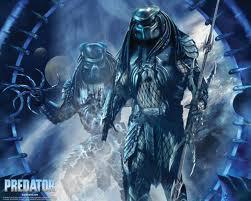
God, I wish. But no.
Let me begin by repeating that animals need to be part of a functional ecosystem, which means keeping them in balance within their environment. Way too many books and movies fall in love with the carnivore, throwing their heroes (or more likely, their heroines) under the slavering jaws of one predator after another, and yes, I am bashing the Riddick franchise again. Carnivores are awesome, but by necessity, they are also few. In Africa, one of the most diverse places on Earth and home to many of the animals we think of when we think of carnivores, the predator/prey ratio is estimated at 1% (discounting insects). Note that refers to the number of animals, not species. Why? Because, as I said earlier, all animals only develop features that help them eat or avoid being eaten (or mate, but we covered that). Large numbers help herbivores avoid being eaten while small numbers help carnivores eat by avoiding competition.
But what the hell are you going to do with your characters if you can’t threaten them with slavering predators, you ask? Simple. Threaten them with prey. Some of the most dangerous animals in the world are herbivores. Hippos look so cute in a tutu that’s you’d never guess they have killed as many as 3000 people in a year—more than lions, sharks and crocodiles combined. The cape buffalo are so notoriously aggressive that they won’t just trample a man to death, they’ll actually camp the corpse, stomping and goring in increasing fervor until nothing’s left but a muddy, bloody puddle. Numerous insects, fish and frogs, otherwise no danger to humans, secrete venom lethal enough to kill a man many times over. Predators and prey evolve together; the more deadly the carnivore, the more aggressively the herbivores defend themselves.
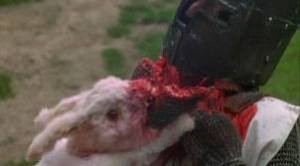
You should see the fox.
Well, I guess that brings us to the end of the series. I hope I’ve helped you consider some new aspects of worldbuilding or at least that you weren’t too bored. Enjoy the rest of the month and let me know how you did at meeting your Nanowrimo goals!


November 24, 2013
Y is for Youth
Y is for Youth
He was little, that was the first thing. Standing up, he might only come to her knee, but otherwise he was a perfect little scale-model in miniature. His shell was a kind of bright bluish-green, cheerful in the sunlight, and his tiny antennae jittered like the wind-up arms on a tin toy. He was wearing a toddler’s tee, pulled up and secured with bands of electrician’s tape into something like a cotton harness. His pants were pajama bottoms, dark blue with rocket ships and stars on them, pulled up and fastened at the knee-joint with neon-colored hairties in pink and green. He was sitting in the dirt, in between the blade of a lawnmower and some massive soot-black engine, with half a milk jug and some tin cans before him, playing Trucks. –Cottonwood
* * *
“I was well into my majority when he was born, yet well I remember him as a lad, lining his iron warriors across the foot of his bed and striding before them, giving the most heartening battle addresses ever issued from the mouth of a six-years’ before marching them to their fates. And the medals he gave to the victors, ha! And the funerals to the fallen…” —The Army of Mab
* * *
So you’ve gotten over your fear of alien interspecies sex and your character has spent the night being written into several compromising positions with a variety of jointed, barbed and prehensile appendages. Now that she just might be getting ready to lay two or three thousand eggs, it’s probably a good time to mention that sex has consequences.

Consequence!
Adding children to your non-human race subtlely suggests continuation and how they raise them allows you to demonstrate your race’s core beliefs without relying on narrative or expositional chunks of text. In fact, one of the best summaries of a people I’ve ever read came directly from a scene with children, from a comic book series called ElfQuest, by Wendy Pini: Children of the Go-Backs play with sharp things. One line. Eight words. And doesn’t that just tell you everything you need to know about them?
But I don’t see a lot of children in sci-fi and fantasy, unless the kid is the hero or the sarcastic guttersnipe sidekick. But why would you, some argue? Unless you’ve got one of your own, how many kids do you see socially, really? It’s true that kids are a lot like Bigfoot—you hear them and smell them a lot more often than you see them, unless you go someplace where they’re known to congregate, like a bouncy house or a Disney movie (‘they’ being kids, not Bigfoot).

Although old ‘Foot does like him a good bouncy house.
So why worry about it? Well, there was a time in the history of sci-fi when a writer could make an alien culture or scientific speculation the whole point of the book, but these days, even sci-fi is supposed to have a plot. In most ways, that’s a good thing. I’m not saying hard science sci-fi is bad. I’m just saying it’s boring. I buy books because I want to hear a good story. I write books because I want to tell a good story. So in that sense, I think it’s great that a writer should be more story-driven than world-driven.
However, the non-human race and non-Earth world is what separates sci-fi and fantasy from other genres, so as writers, we have to make room for those elements in our stories. And while it’s relatively easy to introduce physical traits—the glow of the fey lord’s eyes, the sickly yellow color of the alien sky, the unnatural cold of the selkie’s skin—cultural differences are what really set ‘us’ apart from ‘them’ and they can be more difficult to work in. In my extremely limited experience, the best way to bring out your non-human race’s non-humanness is with five fundamental aspects: sex, death, status, religion and children. The first four probably seem self-evident, but why children? Say your book doesn’t have a smartass orphan pickpocket or endless prissy princess escort quest (thank you for that, by the way). You’re not writing about kids, so why waste time developing cultural attitudes about them?
Because the tree grows as the sapling is bent. In other words, even without kids in your book, your characters were children once and those cultural attitudes made them who they are as adults. In order for you to portray them as multi-dimensional, fully-realized people, they have to have a history, not just a personality. So with that in mind, let’s begin at the beginning.
Birth. A birthing scene is inherently dramatic even when it takes place in a hospital with a doctor telling how to do it. Remove that familiar setting and you create a sense of unpredictability that amps up the tension even more. Do your non-humans even view childbirth as a medical issue? Historically, many people turned to midwives, an occupation usually held by females, who specialize in helping women give birth. Some were trained in this craft, others experienced mothers themselves, and still others a kind of combination healer-hedgewitch who, for all the respect afforded her for her skill, might be otherwise ostracized by her neighbors.
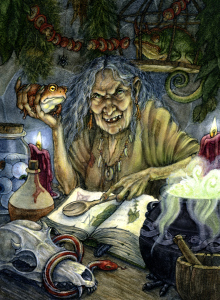
Can’t imagine why.
And what about the birth itself? In some cultures, giving birth was considered a community event and the mother-to-be might expect to see relatives, friends, neighbors and even total strangers traipse in and out of her room, munching canapés and remarking on her performance. For others, childbirth was a solitary affair in which the expectant mother would build a temporary shelter away from her people and remain there until the baby arrived, without help of any kind. For some cultures, only women were permitted to come into contact with the mother-to-be; for others, only family members (related by blood, excluding the baby’s father). Not too long ago, right here in America, it was unthinkable that the mother should have visitors while giving birth. In order to be with his sister while she had her first baby, my father had to register at the hospital as the father of the baby. He did it again a few months later for his other sister. And again a few months later when my mother went into labor. The nurses were really starting to give him dirty looks by then.

“Exactly how many more arrivals can we expect to see this year, Mr. Smith?”
Once the little bundle of drooling delight shows up, there comes the question of what to do with it. For most cultures, the mother provides most if not all of the child’s immediate need, with or without the help of relatives or a mate. Because this is so readily assumed, it’s a fun thing for a writer to play with. In Arcadia, Taryn naturally expects to care for little Lugh as she did for Aisling, but Antilles, as Lord of the Valley, just as naturally assumes Lugh will have a wetnurse and nanny and live in the palace nursery where he grew up. In Olivia, the mother has the sole care of her offspring, but is not permitted to provide for herself; the same gullan who have adopted the radical (for them) notion of a female leader are utterly incapable of allowing the same woman to have a baby but not a mate. For my alien yang’ti in Cottonwood, marriages are extraordinarily rare and parenting is left almost exclusively to the father after the egg hatches. And as I’ve said before, in Heat, neither biological parent is involved in childrearing; women raise adopted daughters and men raise adopted sons.
Once the child hits a certain stage of development, people begin to groom it to join society. For most of us, this means some form of education, and as with childcare, I tried to handle it a little differently with every new race. In Heat, I imagined schools would be for higher education only, with the parent providing the basics; Tagen mentions his father trained him from childhood to enter the Academy, said training often consisting of taking the young boy out into the woods and leaving him there. In Arcadia, the Farasai foals are placed in whatever capacity around the kraal they are most suited to and once they take their paints (at around two years old) this will be their job for life. In The Last Hour of Gann, Meoraq, like all boys born to the warrior’s caste, is sent to the Training Hall at the age of three, returning home only for the coldest part of winter. His lessons include reading, writing, science and all that jazz, with an emphasis on the tenets of his religion and laws, but the real focus would have been on physical training and combat techniques.
Eventually, there comes a time when the child is ready to become an adult and here is where I think we in America have really dropped the ball. See, we don’t have any real ceremony of recognition for young adults. There’s just this blurry phase wherein the kid ideally has a job and most of the typical adult skills, but the parents still provide for most of his care. The closest thing we have to a rite of passage is high school graduation. For most of us, adulthood is a magic number. At eighteen, the law recognizes you as an adult, whether you’re ready or not. In my house, we weren’t adults until we moved out and even then, it was more probation than anything else. I’m almost forty and I still get The Look when I cuss in front of my father.
The reason why adulthood rites are phasing out of fashion across the world is pretty obvious, though: they’re usually incredibly dangerous or painful. I guess the idea is that adults have to deal with the tough stuff whereas kids can still run away or cry or just use common sense to avoid situations where you have to jump off a rickety tower straight into the ground with a frickin’ vine tied to your ankle to break your fall.
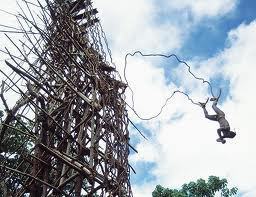
In fact, my mother specifically told me NOT to do this.
Rites of adulthood throughout history and around the world provide eye-opening or occasionally eye-scrunching and cringing examples of what you might consider for use in your alien world. Ritual purifications are a common theme—through intense fasting, sweating, smoke-smudging or just plain bathing—as are tests of endurance, such as ritual beatings or prolonged periods of sleeplessness. Some, especially boys, may be expected to go on a hunt or a raid, proving their right to be called a man through combat. Spiritual worthiness may be tested—many cultures send their youths into the wilderness to invite spiritual direction; others use hallucinogens or other ceremonial drugs to allow the adult-to-be access to the invisible world around them. Stoicism is often a key element of these rites of passage; the young girls of the Mentawai Islands who have their teeth sharpened (with a stone knife or chisel!), the Fula girls who have intricate tattoos raised across their faces by repeated stabbing from sharp sticks, and the many cultures who beat, whip, scar or circumcise boys and girls—all are expected to endure it without giving any sign of pain. Sexual initiations may also occur, as young men and women are instructed by older, experienced persons in various practices or pleasures. (Oddly, from everything I’ve read, this is not as fun as it sounds.)
One last thing (and now that I think about it, it really should have been the first thing). When writing children, give them personalities of their own beyond being cute and take special care to portray them realistically and intelligently. You can’t write them like adults, unless you want them to seem creepy and socially awkward, and you have to be careful of writing them too simply or they’ll come across as idiots. Remember that real children tend to avoid abstract concepts in favor of definite ones; a kid is far more likely to refer to someone else as “the fat man” or “the man with the puppy” than “the nice man”. Avoid overly innocent mannerisms and speech. The best example I’ve been given of this pitfall is the child character who asks, “Why are your eyes wet, Mommy?” Kids cry all the time; they know what crying is. It may be scary to see the infallible Mommy doing it, so they may start crying too or ask her what’s wrong, but they know what she’s doing. On the flip-side is the child who doesn’t know why Mommy gets mad when he cuts up her dresses with scissors. Kids have a finely-tuned, if not over-tuned, sense of what will get them in trouble. It may not stop them from cutting stuff up with the shiny, shiny scissors, but they know damn well why Mommy’s mad, enough to blame little brothers, dogs or random dress-slashing strangers. Allow them to act on impulse and ignorantly put themselves in harm’s way, but keep in mind that kids are aware of danger and do have survival instincts. Childhood is a frankly terrifying time and kids know perfectly well that there are monsters in every dark crawlspace just drooling at the thought of plump and juicy childmeat, all crunchy and screamy and delicious. On a related note, kids may believe in a lot of things adults find silly, but they do know the difference between reality and imagination. Yes, they might believe in unicorns even though they’ve never seen one and yes, they might believe in zombies because they see those in media all the time (the best parent in the world can’t keep all zombies out of a kid’s consciousness anymore than she can keep the sea from hitting the shore), but no matter how much they play “pretend”, they all know toys don’t really talk back or walk around and they will not take that stuff in stride.
As with any other aspect of your book, if you’re going to write about children, research them. If you have a kid, try to observe them in their natural habitat whenever possible, among their own kind. If you don’t have a kid, borrow one (IMPORTANT: Always ask before borrowing children!). Listen to how they talk. Watch how they play, fight, make friends and throw tantrums (you should be able to get that all on one day if you’re lucky). And make sure you get them at the same age as your character because nowhere else does two years make so much difference as it does in a kid’s development.


November 23, 2013
X is for Xenophilia
X is for Xenophilia
“I’m not ‘your’ anything. Just because I slept with you once doesn’t mean I belong to you.”
“You slept in my camp. That means you belong to me. You have been mine from the day—” He stopped there, then rolled his eyes and heaved a hard sigh. “Fine. How many times do humans mate before the woman considers herself conquered?”
She stared at him for a long time before she was finally able to say, “That’s not how it works with us,” biting off each word and spitting it like a bullet.
“More pity for you,” he said with a careless shrug of his spines, “because that’s how it works with us.” –The Last Hour of Gann
* * *
Sex with this particular man was never going to be normal or comfortable or completely free of that awkward “you’re stabbing me with your shell” whisper, but it was still amazing, mind-expanding, world-defining sex. Not because of what he did, but because of who he was, and knowing that anything he did do was solely because he wanted to please her. –Cottonwood
* * *
For those of my readers unfamiliar with the legendary Phil Foglio, xenophilia is a love (philos) of foreigners or strangers (xenos). At one time, I suppose that meant people from another country, but as our world has grown smaller, our idea of what is really strange has pushed outward. When the old gypsy tells the xenophiliac to expect a tall, dark and handsome stranger to enter her life, her expectations may differ slightly from the norm.

I guess what I’m saying is, handsome is subjective.
Yes, today’s article is about how to approach strange sex in sci-fi and fantasy. It’s about damn time, huh?
As I’ve said before, I have long held the opinion that people are people, no matter what they look like, and it’s perfectly natural for people who fall in love to want to have sex. In that regard, I have no squick threshold. None. I don’t care if he’s got fur, scales, horns, wings, chitin, four legs, no legs, tentacles or hooves—if we’re in love, it can only be beautiful.
Not everyone feels that way and that’s fine. But some people who clearly don’t feel that way also write paranormal romances and that’s just baffling to me. Centaurs become human, demons turn gentle, and the shifters always shift. Listen, if your shifter uncontrollably turns into a tiger every time he loses his temper, but stays human for the sex, what does that say about his passion for the heroine?
I’m a bottom-line kind of person and the bottom line for me is this: My readers bought a paranormal book. I have to trust that they want to read about some paranormals. If I weird them out when I take it to the bedroom, I might lose some readers, but that has to be okay. My books aren’t for everyone. Nobody’s books are for everyone. All I can do is tell my story as honestly as I can, and with me that means a sex scene that may include the phrase, “His powerful tendrils coiled around her thighs, lifting and supporting her while his delicate manipulator digits cupped her face.”

I couldn’t find a picture to go with that, so here is a picture of a pug dressed as a taco.
Don’t hide your character’s inhuman qualities, embrace them! Let your reader feel the chill of your vampire’s cold kiss, the scrape of your gargoyle’s rough hands, the tender squelch of your starsquid’s pseudopod. Read Dr. Tatiana’s Sex Advice to All Creation by Olivia Judson for some inspiring peeks into how weird sex can get right here on Earth and see what you can tweak in your alien’s technique. Yes, there’s a risk of squick, but you can’t hide these things without hiding a part of your character. Sex isn’t supposed to be comfortable, it’s supposed to be intimate. It exposes what it embraces. And when you do it right, it transcends. And that’s what we’re all going for, in books and in life—that transcendent moment that joins flesh, in whatever form it takes, to the soul.
So now that we’re all set to write a hot human/non-human sex scene, let’s slow down and consider a few things. Sex involving aliens/shifters/dragons/whatever is not like sex between two (or more. I don’t judge) humans. Here on Earth, we know where all the pieces are and how to fit them together. Sex, despite its many flavors and variations, is fairly straightforward. Non-humans can complicate things in any number of ways, such as:
Not everyone keeps their genitals in the same place. I’m one of those obnoxious pudding-soft science types who doesn’t have a problem with an Earth-like alien planet producing an essentially humanoid alien, but there are other ways to go. I read a book once in which the alien hero kept his reproductive apparatus in the palms of his hands. As a priest sworn to celibacy, he went gloved throughout the story, but it was obvious he was falling in love with the human heroine. At the end of the book, as she stood on the landing dock with her ship behind her, ready to fly away forever, she looked him in the eye and held out her hand. He took his glove off and shook it. It was sex; he knew it; she knew it; no one else knew it, but it wasn’t anyone else’s business. The scene remains one of the most emotionally powerful alien sex scenes I’ve ever read. No, not everyone keeps their genitals in the same place, but sex does not begin and end with the genitals. Just as with any sex scene, focus on the emotional side first, the physical side second, and let it go where it wants to go.
Every culture has its own idea of what’s acceptable and taboo regarding sex. Even with a strong mutual attraction, the likelihood of misinterpreting one another’s signals is high. What’s fun and flirty for one might seem shockingly kinky to the other; one party may view sex as a form of ritual between mortal souls and the gods while the other views it as an expression of love between two people; one person’s booty call could be an alien’s act of marriage—the dramatic possibilities are truly endless.
Maintain an element of danger. When writing a predatory relationship (human/vampire, human/werewolf), keep the other-ness of the predator extremely visible in sex scenes. Resist mightily the urge to humanize (and tenderize) the monster for sex. Constantly call-back to their true natures. Vampire sex will be sensual and perhaps a bit menacing, with a lot of “his teeth scraped over her skin” and comments about how she tastes, as well as that he is cool to the touch and how “she lay her head down over his chest, where his heart would be if it were beating”. Werewolf sex will have less foreplay and more rutting around, with an emphasis on smells and tastes and his breath on the back of her neck.

I found lots of pictures to go with that, but I’m still trying to keep it PG-rated, so here is a picture of a dachshund dressed as a hot dog.
Use all five senses, or more where appropriate. How does his skin taste? How does her hair smell? There are only so many words that can be used in the mechanics of sex, so mix up the qualifiers. The hero who slides his hand roughly up the heroine’s thigh provokes a very different emotional response from the reader than the hero who slides his hand softly up that same thigh. And when your supernormal character is psychic, there is a whole new dimension to sex. Can he only hear her thoughts or can he feel her feelings as well? Would sex be unsettlingly primal? More cerebral? More intimate or passionate? With telepaths, all the usual physical chemistry takes a back seat, since there are no secrets and no lies.
Take it to a new level. As a general rule, there should be only one sex scene in bed. After that, make use of the couch, the shower, the wall, the kitchen table, the maple tree in your neighbor’s yard, the tall fence around the rhino enclosure at the zoo, whatever. Change positions. Explore power plays. Get jiggy with it. And when writing about spiritual sex (tantric or religious sexuality), understand that it is far different from the usual physical experience. Whether you celebrate God with orgasm or achieve transcendence through ritual positions or increase inner power by way of meditative non-climax, spiritual sex is not about the two (or more) people having it, but about what the act symbolizes. If possible, give it a go yourself so that you can understand the experience. Your significant other probably won’t mind helping you with your research.
Keep it in character. If the first sex scene was from the non-human’s POV, try writing the next one from the human’s. The same mechanics can seem fresh with a different perspective. Use the character’s vocabulary, feel his or her excitement and tension. Is there still a fear of harm, a lack of trust? Really use physical differences, don’t ignore them. Sex should always be character-specific and meaningful to your story. If you can change the names and stick the same scene in another book, there’s something really wrong with your character development.
Sex can have unexpected consequences. And no, I’m not just talking about babies. When one’s reproductive parts are fashioned after two different designs, it’s important to remember that these things weren’t meant to go together and there might be some discomfort. Even if there’s no physical conflict, there might be a social stigma attached to the relationship, especially if there are children.

Who could hate a face like that?
Above all, remember to pace your sex scenes appropriately within the book. Shorter stories require a quicker lead into the action while longer works benefit from more sexual tension and character development. In an average length novel (around 75k to 90k words), the rule of thumb is three sex scenes for a romance, five or six for erotic romance and seven or eight for straight-up erotica. Do not try to force sex into every chapter. Even erotica can have gratuitous sex…I learned that the hard way. Keep in mind also that whether erotica or romance, every scene should still move the plot forward. The hottest scene in the whole book can still be gratuitous if it does nothing but interrupt the book with sex. I learned that the hard way too.


November 22, 2013
W is for War
W is for War
“And you must forgive me,” he said dryly, “but I have fought a war before and there was nothing noble in it. Aye, songs now are sung for those who stood before the wizard in the last days of Dis before she fell, but I was there when there was no singing. I was there when the humans marched on Masala. I stood that line and hacked at men who screamed and bled and died just as any Cerosan. I’ll raise an axe in this war that comes, for I believe Taryn when she says it comes, but ‘tis nothing to yearn for.” –The Army of Mab
* * *
“People are dying! The war is over and you’re still killing us!”
“The war?” Now Sutiok turned, sweeping toward her so that his long skirts and trains snapped and billowed in the wake of his own passage. “I desired no war,” he said, his voice like thunder rolling down the hall. “My demands were small. There need never have been any conflict. In my age of solitude, I had built for myself a palace of secret wonders deep under the earth where no man might be troubled by it. I sought only companionship. Did I demand a tribute of virgins? Did I raid them for their favored firstborn?”
He halted just before her, separated only by the two crossed pikes his door-keepers held between them. In the sockets of his hollow lights, a fel light burned, bloody red and full of smoke and sparks. “No,” he snarled. “I raised up their unwanted dead, the merest handful, to reside with me in peace. No one need ever suffer for it. No one need ever lay eyes on them or my terrible self again. Yet they defied me. They slaughtered my helpless children where they stood, too innocent even to know to scream. Now you dare to come before me protesting the war they began, the war they demanded!” –The Land of the Beautiful Dead
* * *
War. Hoo-ah! What is it good for?
Well, quite a few things, as it turns out. Apart from crushing your enemies, seeing them driven before you and hearing the lamentations of the women, war is a powerful stimulant to economic growth, scientific and technological advancement and, of course, political dominance. But it’s a nasty, brutal business for all of that and I’m sure I’m not alone in wishing it could all just stop. However, this series is about worldbuilding and war is such a common element of fantasy and science-fiction that I decided to cancel my sciency lecture on weather and do war instead.

Poop.
The first and arguably most important thing to remember when putting warfare in your book is to do it for the right reasons, by which I mean, your own reasons. It has become a staple of fantasy fiction that elves and dwarves are openly hostile toward each other. Why? Because Tolkien said so. Tolkien may have gotten the idea from the folklore he studied—rife with examples of animosity between fair beings of light and creatures of the underground—or he may have just enjoyed playing up the conflict so he could have two of his characters befriend each other in spite of it. Whatever his reasons were, way too many people adopt the premise without bothering to include a source for the hostilities.
It can be argued that the conflict between dwarves and elves is nothing more than the old-as-Time conflict between force and finesse, ably represented these days by barbarians vs. nobles, technology vs. magic, pirates vs. ninjas, and especially werewolves vs. vampires. Please note there’s nothing inherently wrong with any of these examples. Ninja steals pirate’s parrot, pirate raids ninja’s hometown looking for parrot, ninja is annoyed enough to send pirate cooked parrot, pirate returns to hometown and burns it to the ground, surviving ninjas lay waste to Tortuga, surviving pirates amass fleet with flags depicting running ninjas in flames. Sometimes things just snowball.
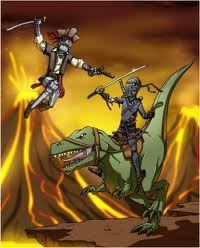
Parrot-napping taken to its logical conclusion.
What makes their use wrong is when people include them as a given, or worse, come up with the most craptastic reasons to indulge them. In the Underworld franchise, for example, the vampires used the Lycans as slaves, which would have been a great reason for a grudge, but it took a tragic romance to get the ball rolling. Really? I doubt I could find ten people on this planet who care about my love life, but every vampire and every lycan is so emotionally invested in whether Sonja should be allowed to have Lucian’s puppy that to this day, they’re all willing to die over it. In my (inexpert and snotty) opinion, that entire movie exists solely to justify the werewolves vs. vampires thing in the first two movies. It had one job and it took the path of least resistance.

I just need to buy one of these and carry it around with me.
By now I expect you’re all willing to agree with anything I say as long as I’ll stop talking about scientist elves vs. pirate werewolves and get back to war. Remember war? This is a blog post about war.
Now I’m not going to waste any time writing about the tactics and weapons of modern warfare. We can all just turn on the news and look at that. I write about aliens and fantasy worlds, so the kind of warfare I know is modeled after either futuristic technologies or ancient ones. And because I lack a lot of hard-science imagination, my future weapons are pretty much amped-up versions of today’s. So let’s talk about ancient warfare.
One of the oddest things about ancient wars is that they were so often structured so that very few casualties actually occurred. Resources were limited, so populations were often small and scattered, and everyone had roughly the same weapons. With notable exceptions, ancient peoples were forced to use diplomatic means to settle their differences rather than risk a bloody conflict that might leave both sides vulnerable to further attack. The solution was apparently to avoid conflict and move as far apart as possible. This had the result of isolating some people so much that they began to develop technology at a different rate than other people. Suddenly, some people had this thing called a strategic advantage and just as suddenly, we start seeing evidence of battles in the archeological record.
The first bows clearly swept over lands where previously only hand-held weapons were known. The advent of large-scale farming allowed people to live together in greater numbers and to fortify themselves against invaders. This led directly to the invention of siege weapons. The adoption of armor, alloys, chariots and boats each created unstoppable armies in their time.
And then came currency.
Prior to the invention of money, even large-scale battles were fought for basic reasons—for food, for land, for revenge, for slave-labor. But with money, suddenly war could be a job. Cultures that were already predominately war-like could now specialize in combat without worrying about little details like growing crops or caring for livestock. And as is so often the case, specializing in a skill soon made those specialists the best. Somewhere along the way, someone realized that rather than take money and buy food, you could just conquer farmers and cut out the middleman. The main objective of war swiftly becomes expansion and populations become empires with the army under the direction of the ruling elite, who were themselves invariably military commanders.

I think I may have been the History Channel in a previous life.
How does any of this relate to worldbuilding? Well, listen, you remember what I said earlier about how you can’t have elves hate dwarves for no reason? The thing is, you can’t have anybody hate anybody for no reason. I know, I know. In real life, that happens all the time, but people don’t read books looking for reality. Realism, yes, but not reality. What’s the difference? Realism has to believable; reality doesn’t. Real life is full of the most outrageous, amazing, and just plain unrealistic coincidences anyone could imagine. You can’t get away with that in a book, where success is measured by suspension of disbelief.
So unlike the wars in real life, you have to understand the war you write into your book—why it started, who’s got the advantage and how it’ll end, even if it doesn’t end within the timeline of your book. And as an extra lick of unfairness for people who write fantasy, you also need to know the unknowable, how supernatural beings or abilities could affect the outcome. After all, what good is a gun against a vampire?
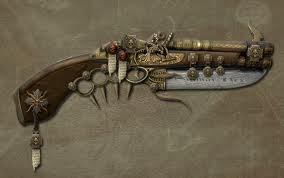
Depends on the gun.
If you are interested in ancient warfare, I highly recommend Warfare in the Classical World by Jorn Warry (covers pretty much only Greece and Rome, but is full of pictures); Greek Fire, Poison Arrows and Scorpion Bombs: Biological and Chemical Warfare in the Ancient World by Adrienne Mayor; anything in the Fighting Techniques series (I own Fighting Techniques of the Ancient World and the Medieval World, but they go all the way up to the Early Modern Era); Norse Warfare by Martina Sprague; The Archaeology of Weapons: Arms and Armor from Prehistory to the Age of Chivalry by R. Ewart Oakeshott; A Glossary of the Construction, Decoration and Use of Arms and Armor by George Cameron Stone; Arms and Armor of the Samurai by Ian Bottomley; and of course, Sun Tzu’s The Art of War. In the don’t-judge-me category of reference books, I also own the Ultimate Equipment sourcebook from the Pathfinder RPG, the Weapons and Armor Compendium from the Palladium RPG and The Lord of the Rings: Weapons and Warfare—An Illustrated Guide to the Battles, Armies and Armor of Middle Earth, by Chris Smith (no relation).


November 21, 2013
V is for Vade Mecum
V is for Vade Mecum
Buk (African goddess); goddess of rivers and streams and the source of all life. It is from her essence that the River that Flows Between is made, and for a brief time, she was Anu’s consort. She was the only survivor among her pantheon after the second mage wars, and on coming to Arcadia, she succumbed to grief. Immortal, she cannot die, but neither can she coalesce and live. The river of her existence flows, but all that made Buk’s divine soul is irretrievably gone. –Notes from the Arcadian Compendium
* * *
‘I want you with me today, Mara,’ thought Horuseps, all the light of humor gone from his mind.
**What are you so worried about?** she asked, helping herself to a small brick of cheese. She had to scrape off the mold with her thumbnail. **Isn’t this what you wanted? Isn’t this what you had such great fun setting in motion yesterday?**
‘I didn’t realize they’d band together this way. They never have before.’
**For all I know, you’re behind this too. Just another one of your little games to keep me from finding Connie.**
He laughed, drawing curious glances from the other Masters at the table. ‘I don’t use humans as my gamepieces, precious. They’re too unpredictable.’ –deleted scene from The Scholomance
* * *
SUPERNATURAL APPEARANCE MODIFIERS (roll d100)
1-2 Unusual skin color
3-4 Striped
5-8 Scales, snake-like
9-11 Scales, crocodilian, pebbled and raised
12-18 Fur
19-20 Winged (leathery)
21-22 Winged (feathers)
23-24 Winged (light/shadow, insubstantial)…—a small piece of my character generator
* * *
From the Latin vade (the imperative “Go!” or “Walk!”) and mecum (“with me”), meaning literally, “Walk with me,” the vade mecum is another name for the author’s compendium, a concise referential book in which notes for a particular work are kept. This can be an actual notebook, a file on your computer, or whatever helps you to keep your facts straight. It is also, bar none, the single most important tool in worldbuilding.
Lest you think I exaggerate, put your hands up if you’ve ever read a book wherein the main character’s name, hair or eye color changed mid-way through. Quite a few hands out there, I’m guessing. This is because it is ridiculously easy to blank on details, even if it’s your first book, let alone your fiftieth. When you write about a non-human character or non-Earth setting, your odds of forgetting the name of the slave girl or the color her eyes turn when aroused exponentially grows.
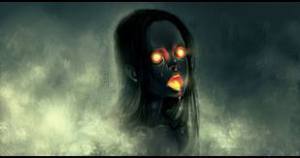
She is so turned on…
Writing is an act of intimacy between an author and the whole world, and like all intimate acts, different people will go about it in different ways. Not everybody keeps an author’s compendium. Ten years ago, I didn’t either. Now I can’t imagine not using one. In fact, I can’t even imagine using just one.
I have a separate compendium for every book I’ve written (sort of. There are two compendiums for the four-book Arcadia series, but there were also fifteen races to document, as well as the usual bestiary and botanical guides) and I carry it with me pretty much everywhere while I’m working. This way, I can write or sketch or remind myself to look this or that up when I get home whether I’m sitting around in the DMV or waiting for a movie to start. As time goes on, this notebook will fill up with snippets, doodles, lists of characters and their vital information, and post-it after post-it directing me to various reference books or websites.
When I start typing, a second compendium of sorts is made: the first file I create isn’t for the book itself, but for its notes—a cleaned-up version of my notebook’s contents along with snippets of story that may or may not make it into the final draft. I tend to write without an outline until very near the end of the book and I don’t write in a linear fashion, so a lot of my scenes float until I get a grip on the timeline. Also, having a place for deleted scenes makes it much less painful when it comes time to mutilate my favorite parts to make a better book.
In addition, I have a kind of Master Vade Mecum: a file on my computer containing my master list of characters (noting hair and eye color, any remarkable characteristics, and what book they appeared in). This is the list that prevents me from having all green-eyed heroines or putting someone named Marcus in every book. The only story elements that appear in this document are asterisks beside the names of any characters available for use in future books; John, Taryn’s ex-boyfriend from The Care and Feeding of Griffins, for example, returns as Norah’s boyfriend in Pool. By doing this, I put all my books inside the same canonical storyline, which makes it even more important that I keep track of all the pieces I have in play.
The flip side of the author’s compendium is the author’s conceptualizer. I’ve mentioned before how I wrote out my own fantasy role-playing game guides, so it really shouldn’t come as a surprise to anyone that I also threw together my own system for how to roll up a character in a book. Yeah. With dice. Ten-sided dice mostly, although you’d need a full set to roll on everything. Because I’m awesome, that’s why.
Some of my characters leap from my head like Athena, fully grown and armored, spear in hand and owl on shoulder, but not all of them. In fact, I never got a good bead on Olivia, which is why I never really describe her. That s***’s just embarrassing. Hence the character generator, which randomly determines attributes like intelligence and endurance, physical appearance, personality traits, strengths and weaknesses, and even elements of a backstory.
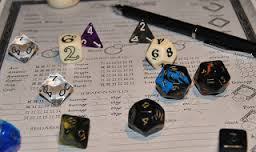
Anything to keep from working, huh?
When it comes to making sense of all this information, organization is key. If you were to come to my house, you would find just a jaw-dropping mess of a work space and you would probably ask me what the heck I’m doing writing about organization. And I would run to my room in tears and huddle up on my bed with my plushie Jack Skellington while you stood outside my door, softly knocking and telling me you didn’t mean it like that while rolling your eyes. Later, you would take me out for a sundae and as we sat across the booth from one another, scraping caramel and soft-serve into a creamy swirl, your hand would just brush mine and our eyes would meet in silent, smiling apology.
What you didn’t understand about my desk is that it is organized, not for neatness, but to help me be in my world. By this perspective, my desk is a living piece of my vade mecum. Those notebooks cluttering up the bottom shelves of my bookcases are my compendiums; I use multi-subject notebooks with tabs so that I don’t ‘lose’ information—the first section is always for characters, the second for my alien cultures, the third for the alien world itself, and so on. The books stacked on the right side of the desk are referential to the work at hand; they’ll live there until the book is done. The toys littering the top of my computer tower are trophies of victory, each representing a different completed novel. The board on the wall above my desk may look like a mess of posters and papers, but it’s where I pin up various inspiring items, like bills. At the moment, there are some photos of old mining camps and caves for Pool, a list of my books with the number of F-bombs I drop in each one (whenever I break the standing record, I have to wear the pottymouth hat for a whole day), and some random pages from a calendar featuring sexy monsters that have nothing to do with my books but which are nevertheless inspiring as hell.
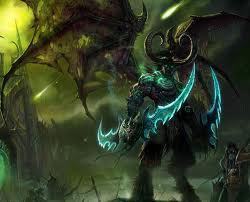
I am prepared.
Webster’s dictionary defines a vade mecum first as an essential manual and second as an important object meant to be carried with the owner at all times. In that sense, I have failed at describing a vade mecum because mine is less of an object than a series of objects in orbit around a central idea. But it’s all those separate things—compendium, conceptualizer, pictures, research, work space—that together enable me to take an idea out of my head and put it into yours with the least amount of spillage. And in that sense, I believe I have described a vade mecum very well: Walk with me. Into Arcadia. Into the Scholomance. Into Cottonwood.
Walk with me.


November 20, 2013
U is for Unearthly
U is for Unearthly
Had he ever been a man once? He had two eyes, burning out of their sunken sockets with a dim and fiery glow. He had the suggestion of a nose, broken badly and then sheared away so long ago that even the scars were clean and smooth. He had half the face of a porcelain prince and half a melted candle; below his left eye, there were cracks that opened wider as they spilled down his cheek into gaps that exposed his teeth and the white stripe of tendon before sealing again at his throat. If he had been a man, a live man, he was dead now. And if he was dead, why should he care if he killed the world? –The Land of the Beautiful Dead
* * *
He had two eyes aimed forward just like hers (except for being too big and for the color, which was a deep red, flecked with gold), under a heavy brow-ridge lined with pebbly scales that became a tight double-row of flexible spines that swept over the top of his skull to about halfway down his neck. His nose and mouth were combined into a dragonish snout, which was broad, lipless, and immovable except at the corners; she could see the point of his thick, rigid tongue when he opened his mouth to speak, but couldn’t figure how he was shaping his words at all. Like a parrot, he just spilled out sound, then closed his mouth again and looked at her. It was easy to imagine she saw frustration mounting in those reptilian eyes as she tried to repeat him, and eventually he quit talking at all. –The Last Hour of Gann
* * *
I’ve been talking all month long about worldbuilding with a strong slant towards non-humans because, let’s face it, you probably already have a pretty good grip on the world humans already inhabit, but also because I love non-humans and the market suggests I’m not alone. Paranormal is huge these days, spanning every medium and crossing every genre. But with so many writers dipping their pens in the same ink (that sounds much dirtier than it actually is, I swear), can there be anything new left to say?
Oh yes. See, that’s the thing about the supernatural—by definition, it embodies that infinite space beyond human understanding and expectation, so there’s always more to say.

Having said that, enough with all the vampires already!
There aren’t a lot of rules when it comes to writing about aliens or other super-normal beings. The super-normal exists by bending rules, after all. Writing nine novels may not qualify me as an expert, but I’ve read hundreds of others and watched thousands of movies, and there are definite qualities shared by what I think are the “good” ones and other qualities shared by the “bad” ones.
First and foremost, respect the rules. When writing about the Big Three—Zombies, Werewolves and Vampires—be aware that they belong to the collective consciousness; everyone knows what they are and how they behave. It’s incredibly important that you bring something new to the party and make your zombies/werewolves/vampires distinct and memorable. At the same time, if you choose not to follow certain traditional rules, say if your vampires aren’t affected by sunlight, you had better acknowledge the discrepancy because your readers will be wondering. And in doing so, resist the urge to wink at other books. What’s a wink, you ask? Say Twilight annoyed you. Say you decide to write a book with vampires in it. Say your vampires can go out in daylight. Do not have some smartass character ask why he or she doesn’t sparkle. Referencing pop trends can be good for a laugh, but it dates your book like nothing else can. You want readers to pick up your book in ten years and still get the jokes.
Secondly, keep a detailed concordance. If your fey characters possess magic, know what they are, what they require, and what weaknesses may exist. Keep these notes in a visible place while working. I have read so many books where the one-eyed character rolls his eyes, the glowing character hides in the dark, and the non-breathing character sighs.
When it comes to wizards, witches and fairies, beware of giving them too much magic. Truly omnipotent characters aren’t badass, they’re boring. If you can solve all your problems with a wave and a magic word, where’s the suspense? Magic, like all power, is ultimately finite. It should have a source and can burn out if overused.

Mana potions: Drinking away your mage’s troubles since the First Age of Dragons.
Third, keep it real. Yes, it’s supernatural, but remember that no matter how alien your world or how magical your characters, realism comes from emotions and flaws rather than extraordinary powers. Your character’s feelings and actions are what the reader falls in love with. And speaking of extraordinary powers, think twice before over-powering your characters. If your vampires are allergic to silver, all of them are allergic to silver, including your vampire hero. If it’s absolutely imperative that a character break the rules, make sure the threats he or she faces remain truly threatening and require heroic sacrifices equal to their superior strength.
When writing about ancient or otherworldly supernormals in the modern age, allow for growth and change appropriate to their situation. A 400-year old vampire who has been living among humans almost certainly has picked up some modern slang, but if your demon has just manifested on Earth for the first time in a thousand years, his speech will be considerably more archaic. Avoid at all costs having a cast of super-normals who all look, talk and act exactly like ordinary humans. If they are all interchangeable with humans except for their powers, this isn’t a paranormal book, it’s a comic book.
Finally, a word of caution. (Haven’t they all been words of caution? Yes, but this is cautionarier.) Introducing a supernatural element to your book also introduces a profound unpredictability. After all, if fairies are real, what else might be real? Then along comes a witch, then a demon, a vampire, a naiad, three or four were-tigers, and before you know it, the entire cast of your 15-book series is made up of super-normals. You’ve lost the human element and made it much, much more difficult to see your characters as outsiders in our world, which was supposed to be the foundation of the series. Remember the lesson The Incredibles taught us: If everyone is special, no one is.
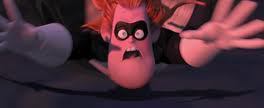
That and no capes.




